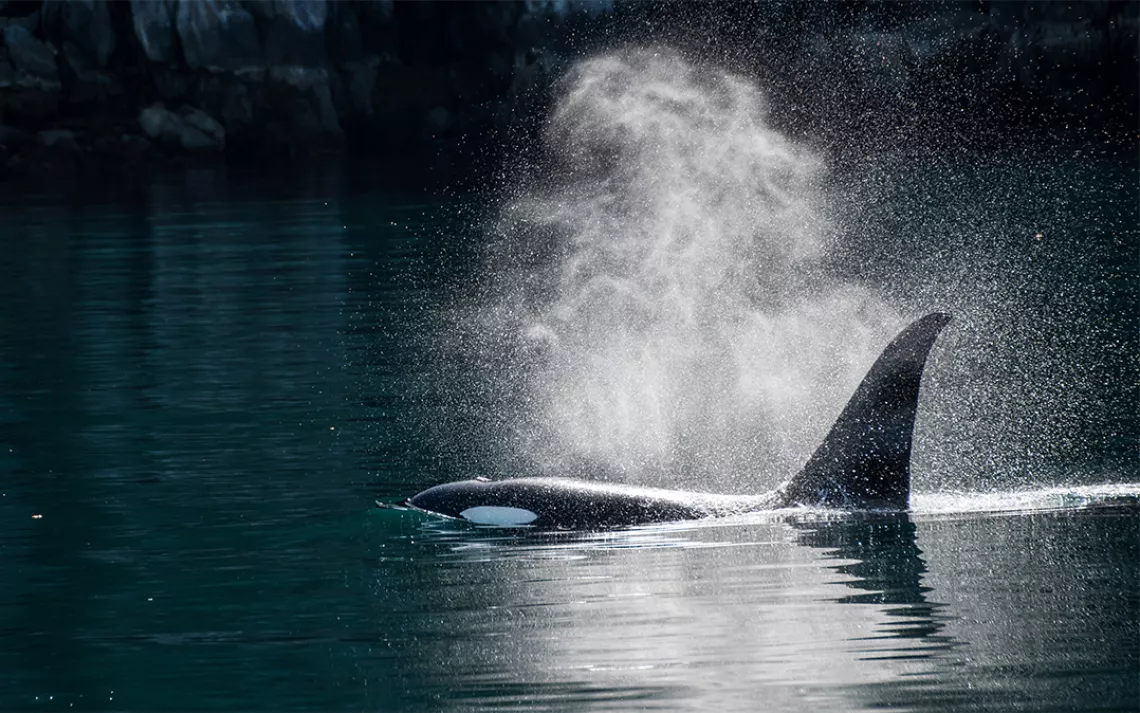Orca Death Brings Science Under Scrutiny
A recent report concludes that a satellite tracking tag contributed to the death of an endangered killer whale

Photo by Rocky Grimes/iStock
Whale researchers don’t typically deal with threatening phone calls or emails. But for the last two weeks, Dr. Brad Hanson, a wildlife biologist with NOAA’s Northwest Fisheries Science Center based in Seattle, has weathered hate mail and angry tirades from the public and disappointed colleagues. That’s because a recently released report from an expert panel concluded that a tagging project he helped develop to study a group of endangered killer whales contributed to the death of one of his research subjects, L95, a 20-year-old male orca. “Obviously I’m devastated by this,” says Hanson, who has spent decades studying the whales. “I got some incredible video of L95 chasing a Chinook up under our boat last year. It feels really sad to know he’s not going to be able to do that anymore.”
On March 30, the carcass of L95, also known as Nigel, was found floating in the Esperanza Inlet of Vancouver Island, British Colombia. A necropsy showed that the killer whale, already suffering from age and poor nutrition, died of a fungal infection in his lungs. A tag attached to his dorsal fin five weeks earlier likely introduced that or another pathogen, contributing to his death. The fungus, it’s believed, was pushed through his skin by the dart, introducing it to an area near a major artery, possibly allowing it to circulate through his system. The report shows that the researchers violated protocol; they attempted to tag L95 once but missed. After recovering the tag from the ocean water, they disinfected it with alcohol but failed to douse it in bleach to completely sterilize the dart after it made contact with the potentially polluted ocean water.
The tagging project, begun in 2013 after years of testing, was designed to help researchers unravel the secrets of the southern resident killer whales (SRKW): three pods of orcas, L, K, and J, that spend summers in Washington’s Puget Sound and the Strait of Juan de Fuca, and overwinter on the coasts of Oregon, Washington, and B.C. In 2006, the 82 whales in the group were declared endangered. While decades of whale spotting had helped establish their summer range, which allowed scientists to delineate critical habitat for their recovery, where exactly on the coast they spent their winters and what they ate during those months was not as well understood.
That’s one reason Hanson decided to investigate whether satellite tagging could work on orcas. While larger species of cetaceans have a layer of blubber where tags can be implanted without causing much damage, small and mid-size marine mammals don’t have the same fat layer. That means dart-like tags need to be attached to the dorsal fin, usually fired at a distance using an air rifle. In 2006, Hanson began working with Russ Andrews of the University of Alaska, Fairbanks, Robin Baird of Cascadia Research, and others to investigate tagging mid-size whales. Researching beaked whales and false killer whales in Hawaii, they modified the tags, which have two titanium darts attached to a transmitter about the size of a 9-volt battery, and perfected their technique for attaching them.
With a track record of over 500 deployments on 18 different species of whales without documented incident, Hanson was ready to try the devices on the SRKW group and received a permit to do so. The idea was to tag the whales and track them via boat on winter cruises along the coast. Between 2013 and 2016, the researchers did just that, darting eight whales, including L95, and collecting samples of feces to find out the whales’ health status and what they were eating.
What they found was that the orcas, typically Chinook salmon specialists, spent their time between the town of Westport on the Washington coast and the mouth of the Columbia River to the south, bringing many other species of fish into their diet. “So we were able to get a lot more information in a very short period about where they tend to spend a lot of time,” Hanson says. “Since 2013 it’s just been a quantum leap in what we’ve learned about what the whales are doing out there.”
Even though the tagging project is now under review, and likely won’t resume for several years—if ever—Hanson believes they’ve collected enough data to help figure out critical habitat for the orcas along their wintering grounds.
Not everyone, however, is so impressed with the tagging data. Kenneth Balcomb is the godfather of SRKW research. In the 1970s, he pioneered photo-identification of the whales, and his group The Center for Whale Research has monitored and researched the whales with NOAA for over three decades. He says the tagging program was unnecessary and too risky to use on this population of whales, which already suffers from a lack of salmon and lives in polluted waters. He says other darts used on the SRKWs, which are designed to fall off after about 30 days, have left festering wounds and bits of hardware. He also reports that two killer whales dart-tagged during an unrelated study of transient whales in 2010 soon disappeared after being tagged and likely died. Though their cause of death is unknown, the tags can’t be ruled out. “We consider the dart implant tagging method far too invasive and risky to be pursued for any species of cetacean, much less for an endangered population of these beloved whales!” Balcomb writes in his official statement on the L95 incident.
He also argues that the research is unnecessary. Years of tracking the whales via photos, whale spotting, and acoustic monitoring has already given scientists enough information to decide on critical wintering habitat, he says. In essence, he asserts, they go to wherever the Chinook are.
Miyoko Sakashita is the oceans program director for the Center for Biological Diversity, a group whose 2005 petition spurred the whale’s listing as endangered in 2006. In 2015, another petition by the group pushed the National Marine Fisheries Service to agree to declare critical winter habitat for the whales by 2017. She says the death of L95 is tragic, but darts are not the biggest threat to the whales. Instead, its time to move forward and address the real problems that are impacting SRKWs, like ocean contamination and dams on the Snake River that have decimated Chinook salmon runs. “I know no one is more sad than the scientists that this happened. It is important they take this step back and look at what is best for the animals. It’s a difficult balance because our policies to preserve and protect these animals is science-based,” she says. “There have been enough studies and data from tagging that we can now take measures to protect them.”
 The Magazine of The Sierra Club
The Magazine of The Sierra Club







